Co-creating symbiotic innovation in the living lab

The EU-funded Baltic Industrial Symbiosis project aims to build knowledge and capacity that supports and accelerates industrial symbiosis development in the Baltic Sea Region. A recent field study in the Swedish forestry sector shows that a method called living lab can be an effective tool for accomplishing this.
Living lab is a method for co-creating user-driven innovation.
“It is about bringing a lot of actors with different perspectives on a development process to co-create knowledge in a real-life context.” says Per Myhrén, project manager and innovation advisor at Paper Province.
In the Baltic Industrial Symbiosis project, Paper Province is responsible for developing living lab as a method to help stakeholders understand the complexity and how to overcome challenges to accelerate symbiotic business models. As a part of this, a test mapping of a promising resource stream has been completed together with business representatives from the forestry and pulp and paper sectors.
“In the living lab, we managed to identify how one company’s secondary resource, or waste, could become a primary resource for another. This adds value to under-utilized resources,” Per says.
From sludge to biochar
The case chosen for the living lab demonstration was “Närskog2” – a Vinnova-funded project exploring how enriched biochar from forest industrial residues can be used as an effective fertilizer for plants and woodlands. The fertilizer consists of residual sludge from the water treatment process in pulp and paper mills, biofuel boiler ash and nitrogen from municipal water treatment plants.
The living lab process took the broader perspective, looking beyond production and taking into account aspects such as potential customers, packaging and transportation. Through interviews, living lab activities and visual mapping, the stakeholders came to a mutual understanding, both from the perspective of the material and the market.
“By working co-creatively, following the resource stream from its origins to the customer and back again and, we are more likely to understand different perspectives. We come to see things alike and identify possible gaps, opportunities and challenges to learn from.” says Lovisa Grönlund, Service Designer at Usify.
Digital format due to Covid-19
Usify are consultants and experts on design thinking and have guided Paper Province though the living lab process. When the Baltic Industrial Symbiosis project started, the plan was to gather stakeholders to meet in person for the living lab demonstration, but due to Covid-19 all activities were redesigned to suit a digital format.
“An important aspect of the living lab is that one can experience the resource stream up close and examine the material and context with all the senses, so it was important to make the digital format as engaging, visual and practical as possible.” Lovisa Grönlund says.
Some participants expressed that the digital format saved a lot of time and made it possible to get an insight into different parts of the stream, much due the visual mapping of the customer and material journey. The visualization was based on interviews and digital field trips and helped generate an overview of the resource stream that triggered valuable discussions.
“Even though future living lab activities hopefully will not be bound to fit a digital format, there can still be great potential in mixing formats and doing some parts digitally for documentation purposes.” Lovisa Grönlund says.
Better knowledge and new perspectives
The stakeholders in the living lab case were representatives from a plant nursery, a pulp and paper mill, researchers at Karlstad University, forest owners, a logistics company, the municipal water treatment plant in Karlstad, a biochar producer and a recycling company. Through the living lab sessions, they identified gaps, challenges and opportunities for the material flow and stakeholder journey.
“We got very valuable information. It was excellent getting the stakeholders from a value chain together around the table. You get the opportunity to see solutions that may not have been visible from the beginning.” says living lab participant Peter Axegård, CTO at C-Green, a company that converts wet biowaste into solid HTC biochar.
“The map of the customer and material journey has been a ‘living’ product throughout this process, which is a must. You continuously discover new aspects that need to be taken into consideration. That is also why the living lab is such a powerful tool; you get to weigh the pros and cons, forming your business model step by step and without losing focus of your stakeholders,” says Per Myhrén.